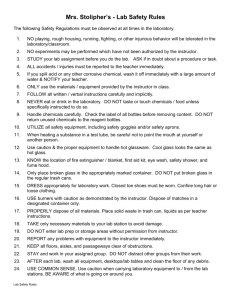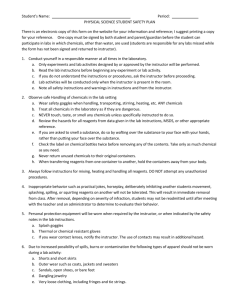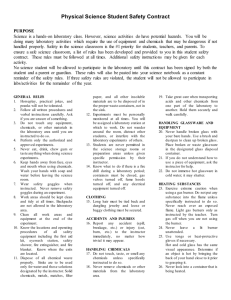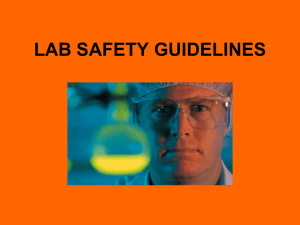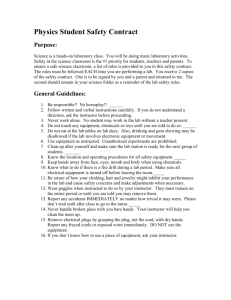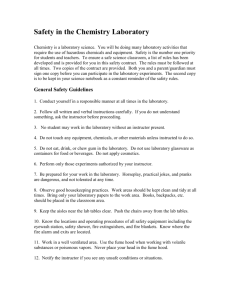Dimond High School - Science Safety Contract
advertisement
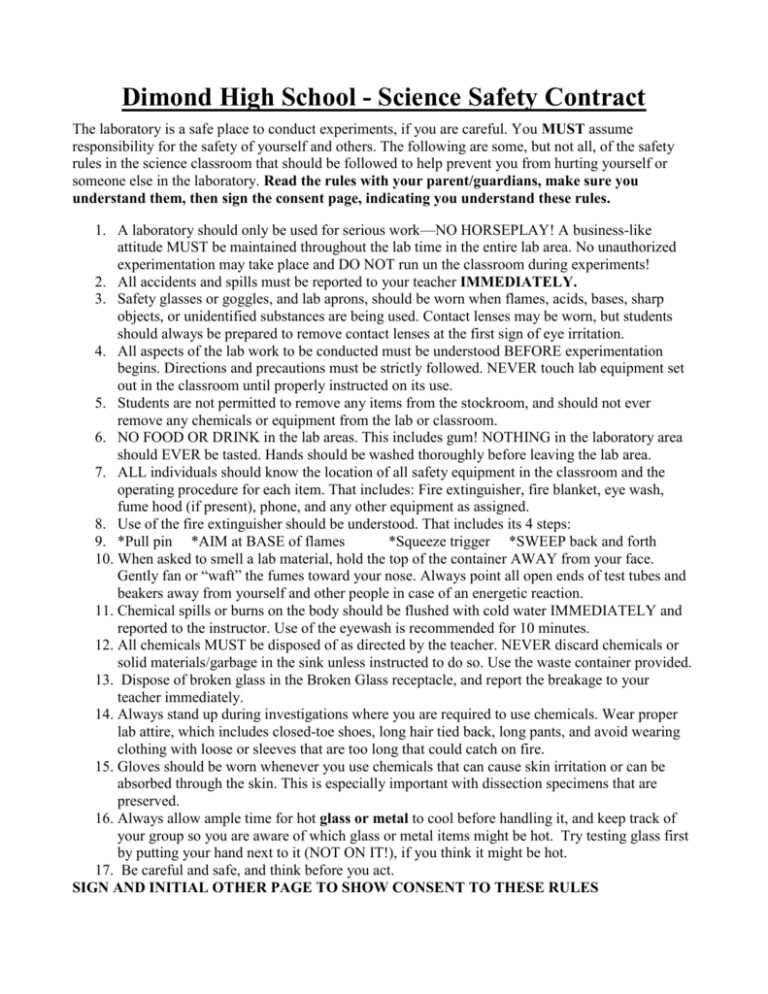
Dimond High School - Science Safety Contract The laboratory is a safe place to conduct experiments, if you are careful. You MUST assume responsibility for the safety of yourself and others. The following are some, but not all, of the safety rules in the science classroom that should be followed to help prevent you from hurting yourself or someone else in the laboratory. Read the rules with your parent/guardians, make sure you understand them, then sign the consent page, indicating you understand these rules. 1. A laboratory should only be used for serious work—NO HORSEPLAY! A business-like attitude MUST be maintained throughout the lab time in the entire lab area. No unauthorized experimentation may take place and DO NOT run un the classroom during experiments! 2. All accidents and spills must be reported to your teacher IMMEDIATELY. 3. Safety glasses or goggles, and lab aprons, should be worn when flames, acids, bases, sharp objects, or unidentified substances are being used. Contact lenses may be worn, but students should always be prepared to remove contact lenses at the first sign of eye irritation. 4. All aspects of the lab work to be conducted must be understood BEFORE experimentation begins. Directions and precautions must be strictly followed. NEVER touch lab equipment set out in the classroom until properly instructed on its use. 5. Students are not permitted to remove any items from the stockroom, and should not ever remove any chemicals or equipment from the lab or classroom. 6. NO FOOD OR DRINK in the lab areas. This includes gum! NOTHING in the laboratory area should EVER be tasted. Hands should be washed thoroughly before leaving the lab area. 7. ALL individuals should know the location of all safety equipment in the classroom and the operating procedure for each item. That includes: Fire extinguisher, fire blanket, eye wash, fume hood (if present), phone, and any other equipment as assigned. 8. Use of the fire extinguisher should be understood. That includes its 4 steps: 9. *Pull pin *AIM at BASE of flames *Squeeze trigger *SWEEP back and forth 10. When asked to smell a lab material, hold the top of the container AWAY from your face. Gently fan or “waft” the fumes toward your nose. Always point all open ends of test tubes and beakers away from yourself and other people in case of an energetic reaction. 11. Chemical spills or burns on the body should be flushed with cold water IMMEDIATELY and reported to the instructor. Use of the eyewash is recommended for 10 minutes. 12. All chemicals MUST be disposed of as directed by the teacher. NEVER discard chemicals or solid materials/garbage in the sink unless instructed to do so. Use the waste container provided. 13. Dispose of broken glass in the Broken Glass receptacle, and report the breakage to your teacher immediately. 14. Always stand up during investigations where you are required to use chemicals. Wear proper lab attire, which includes closed-toe shoes, long hair tied back, long pants, and avoid wearing clothing with loose or sleeves that are too long that could catch on fire. 15. Gloves should be worn whenever you use chemicals that can cause skin irritation or can be absorbed through the skin. This is especially important with dissection specimens that are preserved. 16. Always allow ample time for hot glass or metal to cool before handling it, and keep track of your group so you are aware of which glass or metal items might be hot. Try testing glass first by putting your hand next to it (NOT ON IT!), if you think it might be hot. 17. Be careful and safe, and think before you act. SIGN AND INITIAL OTHER PAGE TO SHOW CONSENT TO THESE RULES ASD Sciecne Safety Form PURPOSE Science is a hands-on laboratory class. You will be doing many laboratory activities which require the use of hazardous chemicals. Safety in the science classroom is the #1 priority for students, teachers, and parents. To ensure a safe science classroom, a list of rules has been developed and provided to you in this student safety contract. These rules must be followed at all times. Two copies of the contract are provided. One copy must be signed by both you and a parent or guardian before you can participate in the laboratory. The second copy is to be kept in your science notebook as a constant reminder of the safety rules. GENERAL RULES 1. Conduct yourself in a responsible manner at all times in the laboratory. 2. Follow all written and verbal instructions carefully. If you do not understand a direction or part of a procedure, ask the instructor before proceeding. 3. Never work alone. No student may work in the laboratory without an instructor present. 4. When first entering a science room, do not touch any equipment, chemicals, or other materials in the laboratory area until you are instructed to do so. 5. Do not eat food, drink beverages, or chew gum in the laboratory. Do not use laboratory glassware as containers for food or beverages. 6. Perform only those experiments authorized by the instructor. Never do anything in the laboratory that is not called for in the laboratory procedures or by your instructor. Carefully follow all instructions, both written and oral. Unauthorized experiments are prohibited. 7. Be prepared for your work in the laboratory. Read all procedures thoroughly before entering the laboratory. 8. Never fool around in the laboratory. Horseplay, practical jokes, and pranks are dangerous and prohibited. 9. Observe good housekeeping practices. Work areas should be kept clean and tidy at all times. Bring only your laboratory instructions, worksheets, and/or reports to the work area. Other materials (books, purses, backpacks, etc) should be stored in the classroom area. 10. Keep aisles clear. Push your chair under the desk when not in use. 11. Know the locations and operating procedures of all safety equipment including the first aid kit, eyewash station, safety shower, fire extinguisher, and fire blanket. Know where the fire alarm and the exits are located. 12. Always work in a well-ventilated area. Use the fume hood when working with volatile substances or poisonous vapors. Never place your head into the fume hood. 13. Be alert and proceed with caution at all times in the laboratory. Notify the instructor immediately of any unsafe conditions you observe. 14. Dispose of all chemical waste properly. Never mix chemicals in sink drains. Sinks are to be used only for water and those solutions designated by the instructor. Solid chemicals, metals, matches, filter paper, and all other insoluble materials are to be disposed of in the proper waste containers, not in the sink. Check the label of all waste containers twice before adding your chemical waste to the container. 15. Labels and equipment instructions must be read carefully before use. Set up and use the prescribed apparatus as directed in the laboratory instructions or by your instructor. 16. Keep hands away from face, eyes, mouth and body while using chemicals or preserved specimens. Wash your hands with soap and water after performing all experiments. Clean all work surfaces and apparatus at the end of the experiment. Return all equipment clean and in working order to the proper storage area. 17. Experiments must be personally monitored at all times. You will be assigned a laboratory station at which to work. Do not wander around the room, distract other students, or interfere with the laboratory experiments of others. 18. Students are never permitted in the science storage rooms or preparation areas unless given specific permission by their instructor. 19. Know what to do if there is a fire drill during a laboratory period; containers must be closed, gas valves turned off, fume hoods turned off, and any electrical equipment turned off. 20. Handle all living organisms used in a laboratory activity in a humane manner. Preserved biological materials are to be treated with respect and disposed of properly. 21. When using knives and other sharp instruments, always carry with tips and point pointing down and away. Always cut away from your body. Never try to catch falling instruments only by the handles. 22. If you have a medical condition (e.g., allergies, pregnancy, etc.), check with your physician prior to working in lab. CLOTHING 23. Any time chemicals, heat, or glassware are used, students will wear laboratory goggles. There will be no exceptions to this rule! 24. Contact lenses should not be worn in the laboratory unless you have permission from your instructor. 25. Dress properly during a laboratory activity. Long hair, dangling jewelry, and loose or baggy clothing are a hazard in the laboratory. Long hair must be tied back and dangling jewelry and loose or baggy clothing must be secured. Shoes must completely cover the foot. No sandals allowed. 26. Lab aprons should be worn during laboratory activities if provided. ACCIDENTS and INJURIES 27. Report any accident (spill, breakage, etc.) or injury (cut, burn, etc.) to the instructor immediately, no matter how trivial it may appear. 28. If you or your lab partner are hurt, immediately yell out “Code one, Code one” to get the instructor’s attention. 29. If a chemical splashes in your eye(s) or on your skin, immediately flush with running water from the eyewash station or safety shower for at least 20 minutes. Notify the instructor immediately. 30. When mercury thermometers are broken, mercury must not be touched. Notify the instructor immediately. HANDLING CHEMICALS 31. All chemicals in the laboratory are to be considered dangerous. Do not touch, taste, or smell any chemicals unless specifically instructed to do so. The proper technique for smelling chemical ASD High School Science Safety Contract fumes will be demonstrated to you. 32. Check the label on chemical bottles twice before removing any of the contents. Take only as much chemical as you need. 33. Never return unused chemicals to their original containers. 34. Never use mouth suction to fill a pipette. Use a rubber bulb or pipette pump. 35. When transferring reagents from one container to another, hold the containers away from your body. 36. Acids must be handles with extreme care. You will be shown the proper method for diluting strong acids. Always add acid to water, swirl or stir the solution and be careful of the heat produced, particularly with sulfuric acid. 37. Handle flammable hazardous liquids over a pan to contain spills. Never dispense flammable liquids anywhere near an open flame or source of heat. 38. Never remove chemicals or other materials from the laboratory area. 39. Take great care when transporting acids and other chemicals from one part of the laboratory to another. Hold them securely and walk carefully. HANDLING GLASSWARE and EQUIPMENT 40. Carry glass tubing, especially long pieces, in a vertical position to minimize the likelihood of breakage and injury. 41. Never handle broken glass with your bare hands. Use a brush and dustpan to clean up broken glass. Place broken or waste glassware in the designated glass disposal container. 42. Inserting and removing glass tubing from rubber stoppers can be dangerous. Always lubricate glassware (tubing, thistle tubes, thermometers, etc.) before attempting to insert it in a stopper. Always protect your hands with towels or cotton gloves when inserting glass tubing into, or removing it from, a rubber stopper. If a piece of glassware becomes “frozen” in a stopper, take it to your instructor for removal. 43. Fill wash bottles only with distilled water and use only as intended, e.g., rinsing glassware and equipment, or adding water to a container. 44. When removing an electrical plug form its socket, grasp the plug, not the electrical cord. Hands must be completely dry before touching an electrical switch, plug, or outlet. 45. Examine glass before each use. Never use chipped or cracked glassware. Never use dirty glassware. 46. Report damaged electrical equipment immediately. Look for things such as frayed cords, exposed wires, and loose connections. Do not use damaged electrical equipment. 47. If you do not understand how to use a piece of equipment, ask the instructor for help. 48. Do not immerse hot glassware in cold water; it may shatter. HEATING SUBSTANCES 49. Exercise extreme caution when using a gas burner. Take care that hair, clothing and hands are a safe distance from the flame at all times. Do not put any substance into the flame unless specifically instructed to do so. Never reach over an exposed flame. Light gas (or alcohol) burners only as instructed by the teacher. 50. Never leave a lit burner unattended. Never leave anything that is being heated or is visibly reacting unattended. Always turn the burner or hot plate off when not in use. 51. You will be instructed in the proper method of heating and boiling liquids in test tubes. Do not point the open end of a test tube being heated at yourself or anyone else. 52. Heated metals and glass remain very hot for a long time. They should be set aside to cool and picked up with caution. Use tongs or heat-protective gloves if necessary. 53. Never look into a container that is being heated. 54. Do not place hot apparatus directly on the laboratory desk. Always use an insulating pad. Allow plenty of time for hot apparatus to cool before touching it. 55. When bending glass, allow time for the glass to cool before further handling. Hot and cold glass have the same visual appearance. Determine if an object is hot by bringing the back of your hand close to it prior to grasping it. QUESTIONS 1. Do you wear contact lenses? YES NO 2. Are you color blind? 3. Do you have allergies? If so, list specific allergies AGREEMENT YES NO YES NO ASD High School Science Safety Contract I, (Student’s name) have read and agree to follow all of the safety rules set forth in this contract. I realize that I must obey these rules to ensure my own safety, and that of my fellow students and instructors. I will cooperate to the fullest extent with my instructor and fellow students to maintain a safe lab environment. I will also closely follow the oral and written instruction provided by the instructor. I am aware that any violation of this safety contract that results in unsafe conduct in the laboratory or misbehavior on my part, may result in being removed from the laboratory, detention, receiving a failing grade, and/or dismissal from the course. _________________________________ Student Signature Date Dear Parent or Guardian: We feel that you should be informed regarding the school’s effort to create and maintain a safe science classroom/laboratory environment. With the cooperation of the instructors, parents, and students, a safety instruction program can eliminate, prevent, and correct possible hazards. You should be aware of the safety instructions your son/daughter will receive before engaging in any laboratory work. Please read the list of safety rules above. No student will be permitted to perform laboratory activities unless this contract is signed by both the student and parent/guardian and is on file with the teachers. Your signature on this contract indicates that you have read this Science Safety Contract, are aware of the measures taken to ensure the safety of your son/daughter in the science laboratory, and will instruct your son/daughter to uphold his/her agreement to follow these rules and procedures in the laboratory. _________________________________ Parent/Guardian Signature Date RATHER THAN SIGN HERE CHECK THE BOX ON MR. MORA’S PERMISSION FORM THAT YOU ARE AWARE OF THE SAFETY RULES (3RD BOX)

